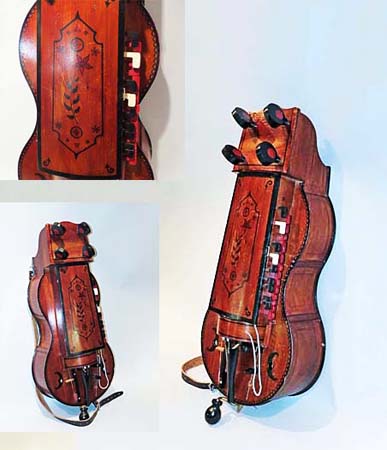
Owner: HWMC
Catalog#: 2CL-CHZT-04
Lutes - Hurdy Gurdy
Hungarian 'Tekerő' Hurdy-Gurdy
Hungary
Folk Instrument
Metal, wood, gut strings, ebony
1987
Length: 29 in, Width: 13.5 in, Depth: 4.5 in
Strings – Lutes – Hurdy-Gurdy
Writing on the inside top of the instrument reads “Heszitette; Barsony Mikaly a nepuriveszet mestere, Tiszaalpar, 1987
The hurdy-gurdy is a stringed instrument that produces sound by a hand-crank turned as a rosined wheel rubs against the strings. The wheel functions much like a violin bow and single notes played on the instrument sound similar to those of a violin. Melodies are played on a keyboard that presses tangents (small wedges, typically made of wood) against one or more of the strings to change their pitch. Like most other acoustic stringed instruments, it has a sound board and hollow cavity to make the vibration of the strings audible. Aside from the melody string, the three drone strings provide a constant pitch accompaniment to the melody, resulting in a sound similar to that of bagpipes.
The Hurdy Gurdy was developed into a small, portable device known as a chifonte (French) or symphonia (Latin) during the 13th century. It was associated with string instruments that were plucked and they played an important role in secular music. Eventually it became established as a minstrel instrument, accompanying lyric and heroic poetry. As it flourished from town to town, the churches began to accept it for processionals and especially during church holidays and festivals with dancing and celebrations.
In Hungary the hurdy-gurdy is called a ‘tekerő’ where it is mentioned and illustrated in the kuruc era (17th century) for the first time. Today the hurdy-gurdy is still played in dances along with melodic instruments (violin, clarinet) in the Szentes and Csongrád regions.
